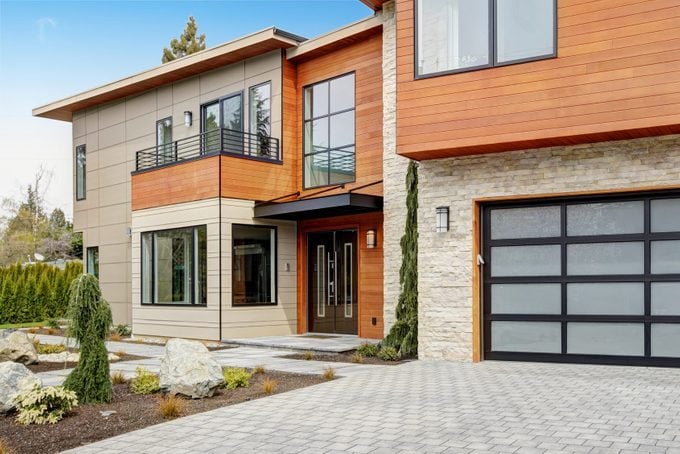Aluminum siding celebrated its 50th anniversary on Sept. 9, 1995. On that date, a Washington Post article called the budget siding material “a marvel of mass production” but also “a suburban eyesore.”
Those two phrases pretty much sum up the main pros and cons of aluminum siding.
Back in 1995, sales of aluminum siding were estimated to be between $6 and $20 billion annually. Although that figure rose to $151 billion in 2020, aluminum now commands only a small percentage of the national siding market. That may be because many homeowners associate aluminum siding more with sheds and outbuildings, or with budget siding for lakeside vacation homes, than their primary homes.
Empire Building offers three reasons why aluminum siding has fallen out of favor: industrial appearance, color fading and vulnerability to denting. Before discounting aluminum, however, it’s important to realize that the list of reasons for choosing it is quite long.
Like all siding materials, aluminum has evolved, even since 1995. Modern aluminum siding is more durable and attractive than earlier versions while remaining budget-friendly. If you’re considering siding for a new or existing residence, there are some good reasons to consider aluminum — and some equally good reasons to pass.
Aluminum Siding Pros
Cost is definitely a factor in aluminum siding’s favor. It’s slightly cheaper than vinyl, fiber cement and stucco, and much cheaper than brick, stone and wood.
Here are some other reasons to choose aluminum over other siding options:
- Rot- and pest-proof: Aluminum is impervious to insects and other pests, and cannot be damaged by mold and mildew. It requires little maintenance and may warrant a reduction in homeowner’s insurance premiums, depending on the insurer.
- Weather-resistant: Besides being waterproof, aluminum doesn’t expand and contract with changing temperatures the way vinyl does. It doesn’t crack or turn brittle with age. Aluminum rusts, but the rust compound — aluminum oxide — forms a protective barrier that prevents further corrosion.
- Paintable: Aluminum siding comes in various colors. When the factory finish fades, you can repaint it without any of the issues you encounter with vinyl.
- Good insulator: Aluminum siding comes in various gauges, and the heavier gauges insulate really well. This makes aluminum a good choice in extreme climates.
- Lightweight and easy to install: Installation costs tend to be lower for aluminum than other types of siding materials.
- Recyclable: Aluminum is considered a green building material because used siding is 100 percent recyclable. This is offset, however, by the environmental impact of aluminum mining, which is considerable.
Aluminum Siding Cons
For many people, the main drawback of aluminum is its appearance, which can be dated and industrial. Cognizant of that, manufacturers have tried to make aluminum more closely resemble wood, imprinting the panels with a grain and finishing them with earth-tone colors. This hasn’t eliminated the stigma for everyone, however.
Besides its appearance, aluminum has other significant drawbacks:
- Easy to dent and scratch: Tree branches flying around in the wind are one possible source of dents and scratches. Dents immediately belie the metallic nature of the material. Homeowners can avoid the worst by installing 53-gauge panels, which cost more than the standard 44-gauge ones.
- Colors fade: The factory finish inevitably fades in the sun, and panels can become chalky. This can present a problem for homeowners hoping to replace a single damaged panel because it can be difficult to find a good color match. Aluminum siding generally needs to be repainted every 10 years to keep it looking its best.
- Pinging noises: Aluminum siding may “ping” in high winds, and sometimes on broiling summer days when heat causes the metal to expand. The noise bothers some homeowners.
Aluminum Siding Manufacturers

Although aluminum has been used in construction by manufacturers like Alcoa since the 1920s, Frank Hoess was awarded the first patent for aluminum siding in 1937. The small company he founded stayed in business until about 1960 in spite of heavy competitions from larger players, such as Reynolds Metals.
Neither of these companies are still producing aluminum siding, but many others are. Here are some of the main ones:
Kaykan
Kaykan began producing aluminum siding in 1974 and expanded its product line to include vinyl siding in 1983. The company has outlets in several U.S. states and Canadian provinces and manufactures two product lines.
Kaykan siding is their standard offering, available in a selection of light colors and a few dark ones. Highly textured Urbanix siding, available in a darker color palette, offers a more contemporary appearance.
Duschene
Quebec-based, family-owned Duschene has been manufacturing roofing and siding products since 1927. It’s a trusted supplier in Canada and sells its products throughout the U.S.
It offers horizontal and vertical siding with plain and textured surfaces in three colors: white, ivory and chocolate. The selection is more basic than extensive, but the company also offers aluminum soffits, fascia and other moldings. It also offers advice on combing aluminum with other materials, like vinyl.
Gentek
Gentek Building Products, a division of Associated Materials, LLC, has been producing aluminum and steel building products for 50 years. It offers three lines of aluminum siding products. The Deluxe line is the original, while the Woodgrain 2000 Series and the Cedarwood series are more recent offerings with textured surfaces that closely resemble wood grain.
One advantage of Gentek siding: It’s manufactured with an extra-deep 1/2-inch butt height, giving it an added dimension you would expect from a material other than aluminum.
Article source here: Pros and Cons of Aluminum Siding


No comments:
Post a Comment